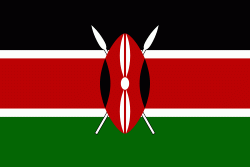Kapsowar
Kapsowar is a Town in Elgeyo-Marakwet County, Kenya. Prior to March 2013, it was located in the former Rift Valley Province. In 1994, Kapsowar became the headquarters of the former Marakwet District. Prior to this, the Marakwet and Keiyo tribes were collectively grouped into the Elgeiyo-Markwet District. In 2010, the two districts were again merged into Elgeyo-Marakwet County. The Marakwet number approximately 200,000 and are a part of the Kalenjin family of tribes, which collectively are the second-largest ethnic group in Kenya.
The town is located between the Kerio Valley and the Cherangani Hills. The land surrounding Kapsowar is fertile and the elevation creates a mild climate with a temperature range of 70-85 °F (21–29 °C). Kapsowar has a population of 82645 2019 census, total population of Kapsowar town Town). AIC Kapsowar Hospital, established by Africa Inland Mission in 1933, is largely responsible for the degree of development presently seen in the town.
The original inhabitants of Kapsowar originate from multiple clans, including Kapterik, Talai and Kapswahili. The Kapswahili originally immigrated from Tanzania and were more or less absorbed by the Kapterik clan. Despite high rates of intermarriage most Kapswahili have retained their Swahili names. The Talai and Kapterik are rival clans. The former is predominantly Protestant and the latter Catholic. They tend to support rival candidates in parliamentary and local elections. Cultural, political and religious differences distinguish the Kapterik and the Talai clans. These are understood to predate the arrival of Christian missionaries. The Kapterik are a large clan who have relatives both in Kapsowar and neighbouring areas and extend to the Kerio Valley. Those in the valley migrated to the larger Kapsowar area because of the mild climate and better possibilities of farming and animal husbandry. This displeased the Talai because of resource competition.
The town is located between the Kerio Valley and the Cherangani Hills. The land surrounding Kapsowar is fertile and the elevation creates a mild climate with a temperature range of 70-85 °F (21–29 °C). Kapsowar has a population of 82645 2019 census, total population of Kapsowar town Town). AIC Kapsowar Hospital, established by Africa Inland Mission in 1933, is largely responsible for the degree of development presently seen in the town.
The original inhabitants of Kapsowar originate from multiple clans, including Kapterik, Talai and Kapswahili. The Kapswahili originally immigrated from Tanzania and were more or less absorbed by the Kapterik clan. Despite high rates of intermarriage most Kapswahili have retained their Swahili names. The Talai and Kapterik are rival clans. The former is predominantly Protestant and the latter Catholic. They tend to support rival candidates in parliamentary and local elections. Cultural, political and religious differences distinguish the Kapterik and the Talai clans. These are understood to predate the arrival of Christian missionaries. The Kapterik are a large clan who have relatives both in Kapsowar and neighbouring areas and extend to the Kerio Valley. Those in the valley migrated to the larger Kapsowar area because of the mild climate and better possibilities of farming and animal husbandry. This displeased the Talai because of resource competition.
Map - Kapsowar
Map
Country - Kenya
 |
 |
| Flag of Kenya | |
Kenya's earliest inhabitants were hunter-gatherers, like the present-day Hadza people. According to archaeological dating of associated artifacts and skeletal material, Cushitic speakers first settled in Kenya's lowlands between 3,200 and 1,300 BC, a phase known as the Lowland Savanna Pastoral Neolithic. Nilotic-speaking pastoralists (ancestral to Kenya's Nilotic speakers) began migrating from present-day South Sudan into Kenya around 500 BC. Bantu people settled at the coast and the interior between 250 BC and 500 AD. European contact began in 1500 AD with the Portuguese Empire, and effective colonisation of Kenya began in the 19th century during the European exploration of the interior. Modern-day Kenya emerged from a protectorate established by the British Empire in 1895 and the subsequent Kenya Colony, which began in 1920. Numerous disputes between the UK and the colony led to the Mau Mau revolution, which began in 1952, and the declaration of independence in 1963. After independence, Kenya remained a member of the Commonwealth of Nations. The current constitution was adopted in 2010 and replaced the 1963 independence constitution.
Currency / Language
| ISO | Currency | Symbol | Significant figures |
|---|---|---|---|
| KES | Kenyan shilling | Sh | 2 |
| ISO | Language |
|---|---|
| EN | English language |
| SW | Swahili language |















